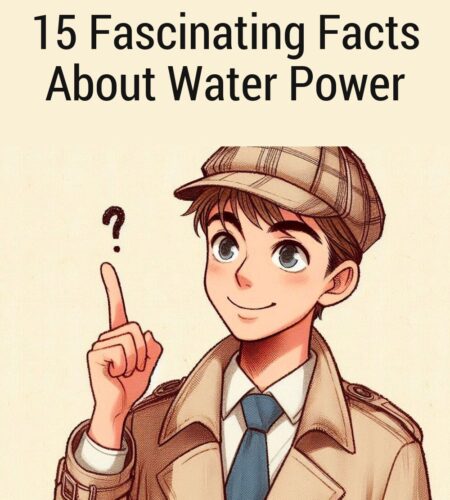Introduction:
Water power, also known as hydropower, is the use of water to generate electricity or mechanical power. It has been utilized for centuries and continues to be a crucial source of renewable energy globally. In this article, we will delve into 15 fascinating facts about water power, shedding light on its importance, history, and various applications.
Fact 1: Hydropower’s Ancient Roots
Hydropower has ancient origins, with evidence suggesting its use as early as 2000 BC in ancient civilizations such as Mesopotamia and Egypt. Streams and rivers were harnessed to turn water wheels, providing mechanical power for tasks like grinding grain and sawing wood.
Fact 2: The First Hydroelectric Power Plant
The world’s first hydroelectric power plant was built in 1878 on the Fox River in Appleton, Wisconsin, USA. Developed by H.J. Rogers, this plant used the flow of the river to generate electricity, lighting up two paper mills and a residence.
Fact 3: The Niagara Falls Power Plant
One of the most famous hydropower installations, the Niagara Falls Power Plant, was opened in 1895. Harnessing the immense power of Niagara Falls, this hydroelectric facility provided electricity to Buffalo, New York, and countless other cities.
Fact 4: Hydropower’s Global Presence
Hydropower is a widely embraced energy source worldwide. Clean, renewable, and abundant, it accounts for approximately 17% of the world’s electricity production. Countries like China, Brazil, Canada, and the United States lead in hydroelectric power generation.
Fact 5: Hydroelectric Dams
Hydroelectric dams are crucial in harnessing the power of water. These structures store water in reservoirs and release it through turbines, generating electricity. Famous dams like the Three Gorges Dam in China and the Hoover Dam in the United States are iconic examples of hydropower technology.
Fact 6: Pumped Storage Hydropower
Pumped storage hydropower systems are unique and innovative. During periods of low electricity demand, excess electrical energy is used to pump water from a lower reservoir to an upper reservoir. When electricity demand increases, water is released back to the lower reservoir, spinning turbines to generate power.
Fact 7: Environmental Impact
While hydropower is a clean energy source, it can have environmental consequences. Large-scale dams can disrupt aquatic ecosystems, alter natural river flows, and impact fish migration. Balancing the development of hydropower with environmental preservation is critical.
Fact 8: Tidal Power
Tidal power, a form of hydropower, harnesses the energy generated by the gravitational forces of the moon and the sun on the Earth’s tides. It involves constructing barrages or tidal turbines to capture the energy produced by the tidal currents.
Fact 9: Run-of-River Hydroelectric Systems
Run-of-river hydroelectric systems utilize a portion of a river’s flowing water without the need for a dam or reservoir. These systems divert water into a channel or pipe, which flows through a turbine to generate electricity. They have a lower environmental impact compared to large dams.
Fact 10: Micro-Hydropower
Micro-hydropower systems provide electricity to smaller communities or individual homes. They can generate power from small streams or rivers using turbines. These systems are an effective and sustainable way to provide electricity in remote areas.
Fact 11: Hydropower’s Role in Water Management
Besides electricity generation, hydropower plays a vital role in water management. Dams and reservoirs help control floods, store water for agricultural irrigation, and provide a reliable water supply for communities.
Fact 12: Hydropower Efficiency
Hydropower systems are highly efficient at converting the potential energy of water into electricity. Modern turbines can convert over 90% of the available energy, making hydropower one of the most efficient forms of energy production.
Fact 13: Hydropower as a Flexible Energy Source
Hydropower is a flexible energy source that can rapidly respond to changes in electricity demand. It can be quickly ramped up or down, providing stability to the grid during peak times or fluctuating energy needs.
Fact 14: Hydropower and Climate Change
Hydropower plays a crucial role in mitigating climate change. It helps reduce greenhouse gas emissions by displacing the use of fossil fuels for electricity generation. The switch to renewable energy sources like hydropower is vital for a sustainable and low-carbon future.
Fact 15: Continued Growth and Innovation
The future of water power looks promising, with ongoing advancements and innovations. New technologies such as underwater turbines, kinetic wave energy converters, and improved fish passage systems seek to enhance the efficiency and sustainability of hydropower.
Conclusion
Water power, with its rich history, global presence, and environmental importance, remains a fascinating and essential source of renewable energy. From ancient water wheels to modern hydroelectric dams, and from large-scale installations to micro-hydropower systems, hydropower continues to evolve and contribute to a greener future. Harnessing the power of water not only generates electricity but also offers solutions to water management and climate change challenges. Embracing hydropower alongside other renewable energy sources is crucial for a sustainable and vibrant planet.
Subscribe to our email newsletter to get the latest posts delivered right to your email.



Comments